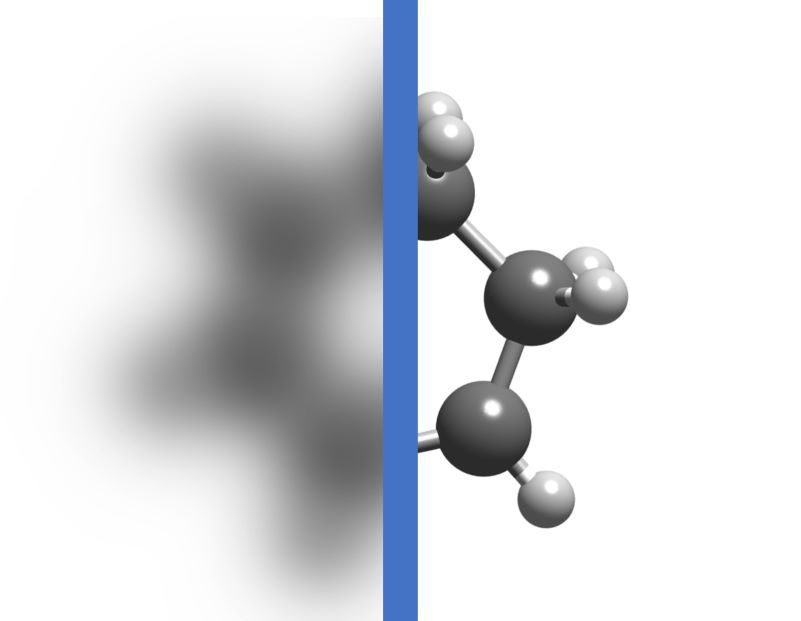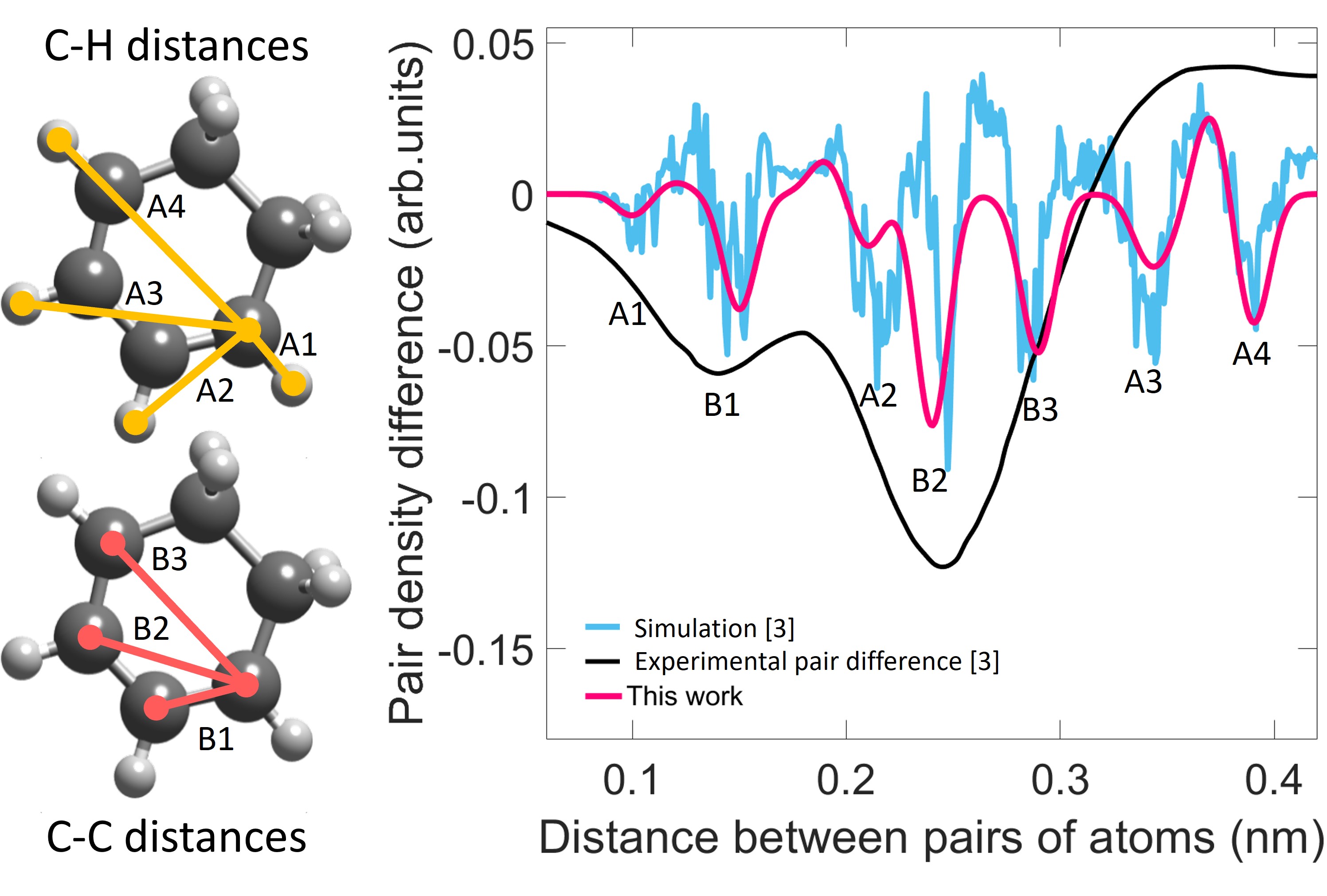| Mar 08, 2023 | |
Super-resolution in ultrafast scattering |
|
| (Nanowerk Spotlight) The Nobel Prize in Chemistry in 2014 was a recognition of the groundbreaking advancements made in the field of super-resolved fluorescence microscopy. The prestigious award was jointly presented to Eric Betzig, Stefan Hell, and William Moerner for their contributions to surpassing the physical limitations of light microscopes, which were once thought to be impossible. | |
| The ability to see below the diffraction limit, which is the smallest size that an optical system can resolve, is determined by the wavelength of light and the aperture size of the system. For super-resolved fluorescence microscopy, this limit can be surpassed using fluorescent molecules that can be used to label structure in a sample. | |
| Super-resolution microscopy has transformed the way we view the biological world, and enabled scientists to visualize biological structures and their interactions inside cells, at a resolution of a few nanometers. | |
| Can we do something similar and see how individual atoms move in a molecule using X-rays? | |
 |
|
| Researchers from SLAC have created a new method for super-resolution imaging that can capture ultrafast atomic motion. (Image: Adi Natan, Stanford PULSE Institute, SLAC National Accelerator Laboratory) | |
| For that, we need to be able to image structures in a resolution of one-hundredth of a nanometer, but also in a millionth of a nanosecond (or a femtosecond), as chemical and physical processes take place. | |
| Probing these extreme length scales and timescales is not accessible with optical light but can be done using powerful machines such as X-ray free-electron lasers (XFELs) and high-energy electron diffraction sources. | |
| For example, XFELs emit hard X-ray pulses with a wavelength on the scale of atoms (around 0.1 nanometers) and durations comparable to molecular vibrations (around 50 femtoseconds). | |
| To capture motions at the atomic scale, researchers use a technique called 'pump-probe'. First, molecules are excited by an ultrashort optical laser 'pump' pulse setting motion in the molecules in a controlled way. Then, to detect changes caused by the pump pulse researchers use a 'probe' pulse at some time delay. In this case, the probe is an ultrashort X-ray or electron pulse that scatters off the sample. To see which atoms are moving, how fast, and where, scientists subtract the steady-state 'unpumped' signal (that can be measured independently without a 'pump' pulse) from the 'pump-probe' signal. | |
| However, even with these machines, it is challenging to get a clear picture of how atoms are moving in real-time. This is due to the unavailability of conventional imaging optics like objective lenses for ultrafast X-rays or electrons. | |
| Additionally, optical super-resolution techniques that use fluorescent markers are not feasible because the size of a molecular bond is much smaller than that of a large fluorescent molecule. | |
| 'Seeing' atomic motion in space and time is therefore not straightforward and such information is often indirectly recovered from the scattering process when X-rays or electrons bounce off the molecules in the sample. The scattering patterns that are recorded on the detector enable researchers to investigate how structures and dynamics change over an extremely short time. | |
| Such analysis, however, is limited to the interpretation of the scattering patterns using advanced simulations and modeling, rather than a direct real-space recovery. This is because the resolution needed to see individual atomic distances in ultrafast timescales is inadequate due to the finite detector size that acts as the effective aperture, as well as the available X-ray wavelengths in XFELs. | |
| Recently, a study by Adi Natan from SLAC National Accelerator Laboratory has made progress in extending super-resolution approaches to the challenging case of ultrafast scattering (Physical Review A, "Real-space inversion and super-resolution of ultrafast scattering"). | |
| Imagine we can create an ???atomic ruler??? with tick marks to measure distances between atoms. We can then calculate how each tick mark would be observed as a scattering pattern and analyzed. The result of such analysis is defined as a 'scattering kernel'. | |
| In an experiment, the measured scattering pattern can be expressed as a combination of kernels that correspond to the unknown distances between the atoms. The ability to super-resolve using the kernels relies on the fact that the scattering process records the information about distances between pairs of atoms, and leverages results from the theory of super-resolution developed by Emanuel Cand??s (Stanford University) and Carlos Fernandez-Granda (Courant Institute) (Communications on Pure and Applied Mathematics, "Towards a Mathematical Theory of Super-resolution"). | |
| For small molecules, atom pair distances are well-defined and occupy only a limited fraction of real space. Using the 'atomic ruler' analogy, the distances between atom pairs in such molecules have simple and well-defined tick marks, rather than a continuous smudge. The conditions to obtain high resolutions depend on the experimental noise levels and the separation distance between the tick marks. These properties are predictable, we can estimate the noise level in the experiment and select an appropriate degree of precision (or graduation) for the 'atomic ruler' we use. | |
| This allows us to determine the conditions and extent to which super-resolution can be achieved. For atomic motions in a pump-probe experiment, the picture can be even simpler, as only atoms that move are detected. By comparing the atomic pair distances before and after the onset of motion with a certain time delay, we can reveal the motion. A positive difference indicates the formation of new atomic pair distances, while a negative difference indicates a reduction in the steady-state distances that existed before the motion began. | |
 |
|
| Figure 1. (Left) Atom-pair distances for steady-state geometry of C6H8. When UV light is shone on this molecule, it undergoes a ring-opening reaction, dramatically changing its structure. (Right) The ab initio simulation (in blue) reveals the difference in pair distances between the excited and unexcited molecules at a 550 femtosecond delay. The individual peaks correspond to atom pairs that undergo significant distance changes during the ring opening, with positive peaks indicating new distances that were formed and negative peaks indicating the drop in steady-state distances. In their study, Wolf and colleagues presented experimental pair density difference results (in black) that were diffraction limited. However, by utilizing the scattering kernels method presented here, we were able to achieve super-resolution (in magenta), resolving individual atom-pair distances. (Image: Adi Natan, Stanford PULSE Institute, SLAC National Accelerator Laboratory) | |
| To demonstrate recovery of atomic distances below the diffraction limit, the study analyzed a pump-probe experiment that tracked the ring-opening process of the molecule 1,3-cyclohexadiene (C6H8) (Nature Chemistry, "The photochemical ring-opening of 1, 3-cyclohexadiene imaged by ultrafast electron diffraction"). | |
| Shining UV light on this molecule initiated a ring-opening reaction, a classic example of electrocyclic reactions in organic chemistry and a model for photobiological reactions in vitamin D synthesis. The dynamics of this molecule can be calculated using state-of-the-art ab-initio quantum chemistry theory, so it can be compared to experimental results with a high degree of accuracy. | |
| The scattering information of the above experiment was re-analyzed using the scattering kernels method, and real-space super-resolution recovery of molecular dynamics was achieved as presented in Figure 1. The method agrees well with ab initio simulations reported in the above study and demonstrates the capacity to resolve individual atomic distances in the molecule during the ring-opening reaction. | |
| This method holds tremendous potential for aiding scientists from various communities who rely on X-ray, or electron scattering to study structural dynamics. Furthermore, it paves the way for real-time imaging of quantum dynamics, enabling researchers to reconstruct the shape of coherent wavepacket motions. | |
| Provided by SLAC National Accelerator Laboratory as a Nanowerk exclusive. | |
|
Become a Spotlight guest author! Join our large and growing group of guest contributors. Have you just published a scientific paper or have other exciting developments to share with the nanotechnology community? Here is how to publish on nanowerk.com. |
|
